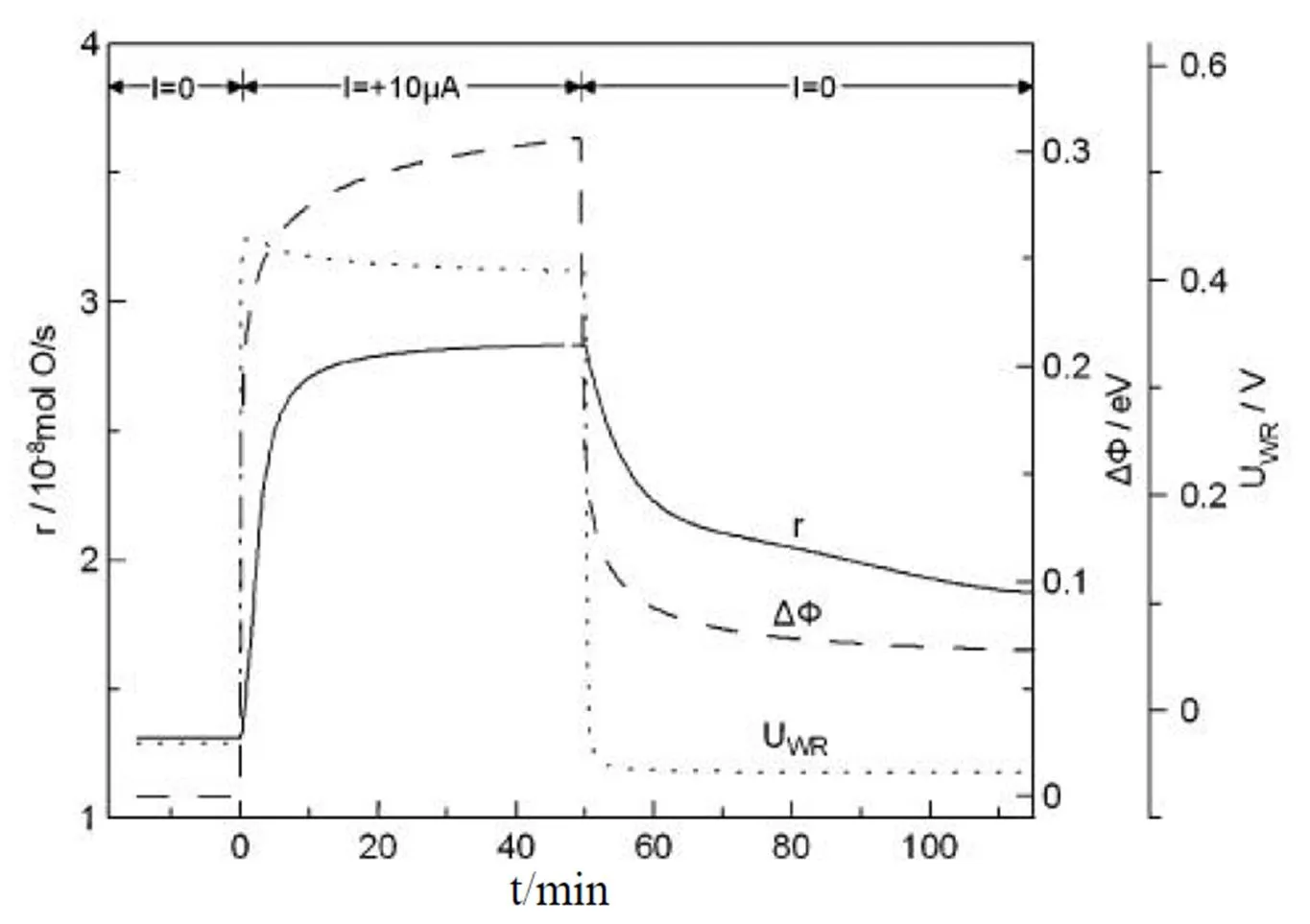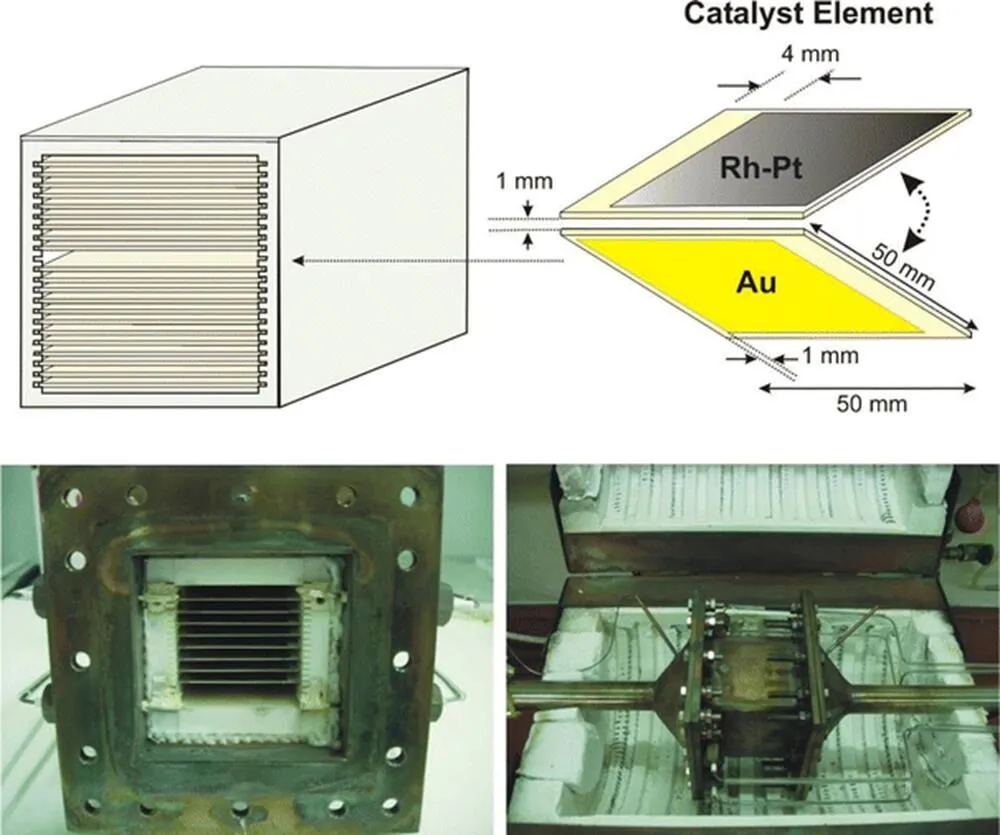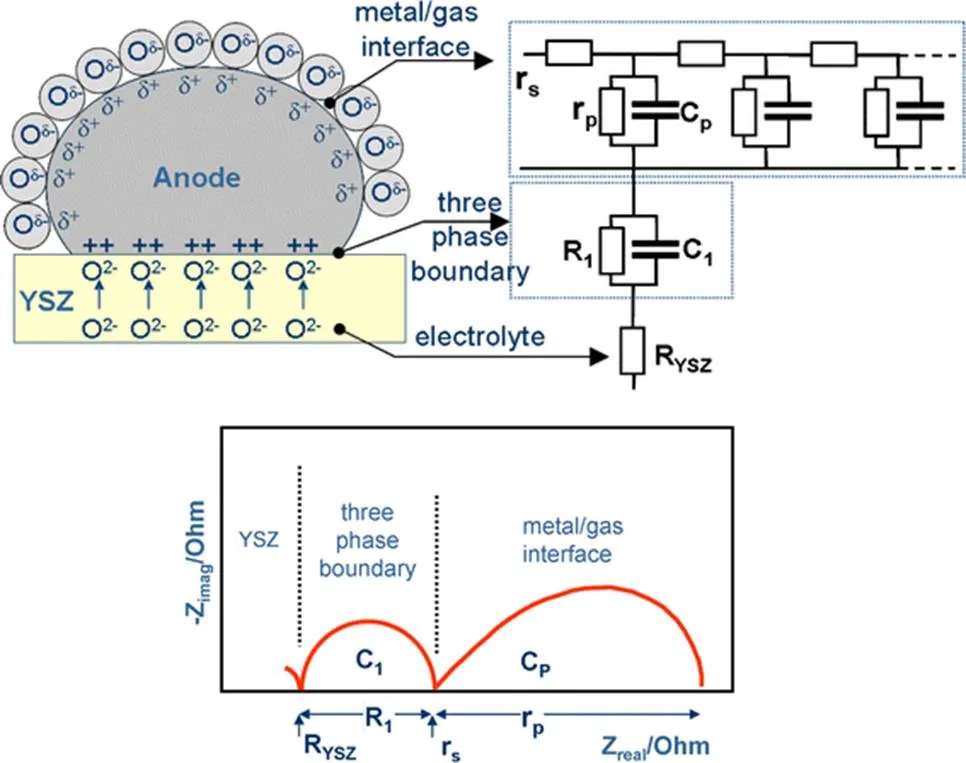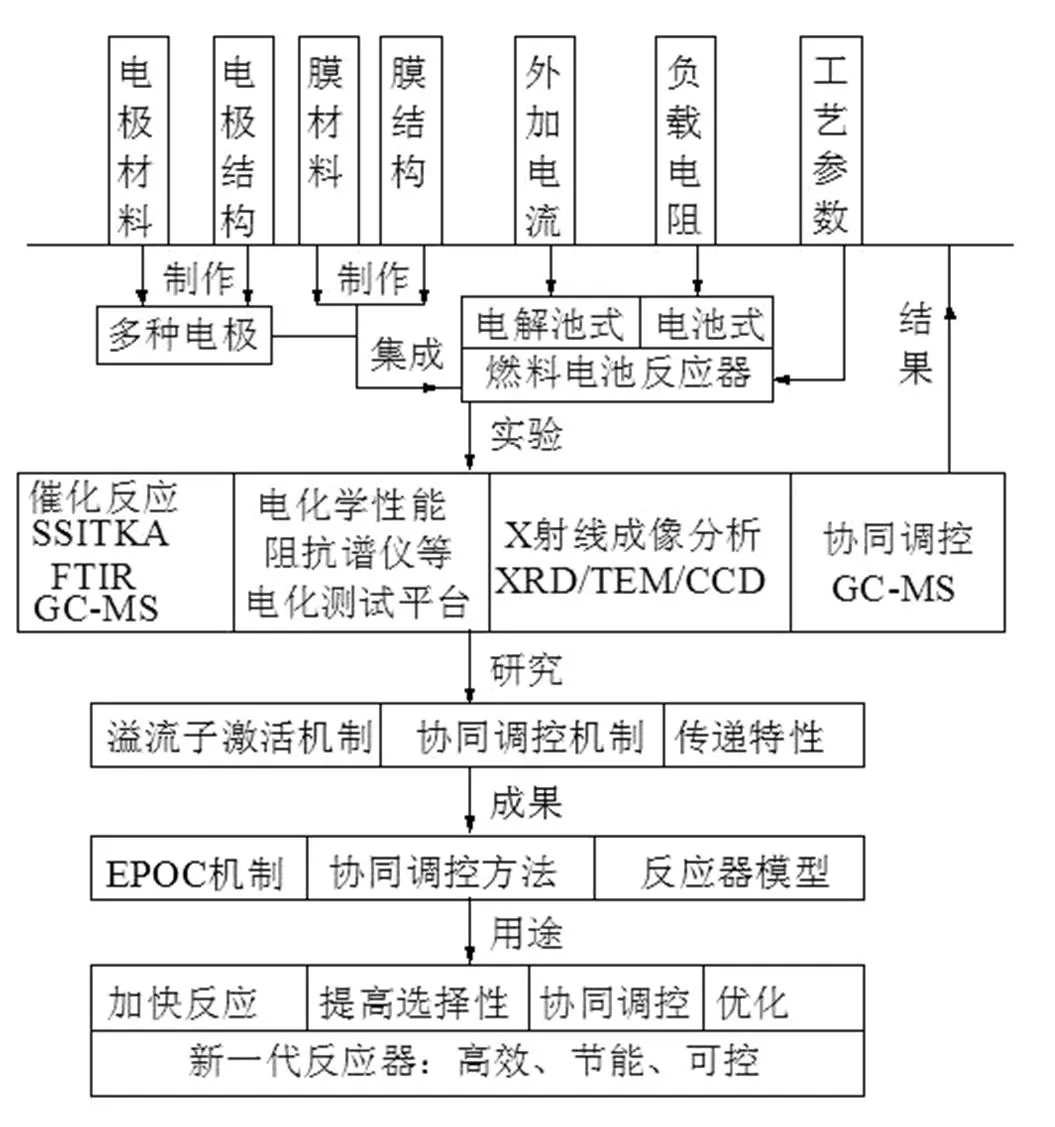电化学增强催化的研究进展
2014-03-15陈海辉
陈海辉
电化学增强催化的研究进展
陈海辉1,2
(1.井冈山大学化学化工学院,江西,吉安 343009;2. 清华大学化学系,北京 100084)
电化学增强催化(EPOC)通过电化学方式可在线控制化学反应进程,施加较小的电流或电势可以引起催化反应速率、产物产率或选择性有显著的变化,是近30年来电化学领域最令人激动的发现,对催化和电化学具有重大影响。本研究综述EPOC机理、研究应用进展,建议进一步研究EPOC的方向和技术路线。研究了EPOC型燃料电池堆反应器(MEPR),探索其传递特性、调控机制,有望获得基础性、前瞻性、战略性的科技成果。随着燃料电池的发展,催化膜成本将进一步降低,催化效率将显著提高,这种新型反应器最终将能满足工业规模化生产要求。
电化学增强催化(EPOC);电增强型反应堆(MEPR);燃料电池反应器;催化;反应速率
电化学增强催化(Electrochemical promotion of catalysis , EPOC)架起了连接催化和电化学领域的桥梁[1],是近30年来电化学领域最令人激动的发现,对催化和电化学具有重大影响[2]。1981年M. Stoukides[3]当从暴露在乙烯和氧气环境的Ag膜催化剂表面供给或除去O2-时,按如图1所示施加25微安电流后,CO2生成速率可提高20%。1990年C. G. Vayenas[4]在nature上宣布只要施加使催化剂极化至一定程度的电流或电压,催化反应速率将显著增加。C. G. Vayenas命名此现象为催化剂活性的非法拉第电化学修饰效应 (non-Faradaic electrochemical modification of catalytic activity,NEMCA)。J. Pritchard[5]在同期nature上高度评价这一亮点发现,并称此为EPOC或EP效应。EPOC的研究意义在于:不同于气相组成的调整或催化剂助剂的作用,它可以施加较小的电流或电势引起催化反应速率、产物产率或选择性的显著变化,即化学反应可通过电化学方式在线控制。本研究将对EPOC机理及研究应用进行综述,指明进一步研究方向。

图1 电增强式燃料电池反应器
1 EPOC实验研究
1.1 NEMCA研究进展
1.1.1 NEMCA的发现
1981年M. Stoukides[3]发现,当从暴露在乙烯和氧气环境的Ag膜催化剂表面供给或除去O2-时,乙烯的氧化增加速率是供给或除去O2-速率(I/2F)的300倍[3],如图1所示。1988年Yentekakis[6]在以Pt 为催化电极将CO 氧化为CO2的类似实验中,发现催化速率增加Δr 大约为供给或除去O2-速率的500 倍。1989年Bebelis[7]在SOFC膜反应器中进行了乙烯深度氧化为CO2的实验,Pt为催化剂电极,Δr为I/2F的3×104倍,首次提出NEMCA概念,如图2所示[2]。

图2 NEMCA效应
1.1.2 NEMCA的推广
1991年C. G. Vayenas[8]在Pt/β″-Al2O3燃料电池上,利用碱性根离子(OH-)作溢流子,进行C2H4氧化反应时发生了EPOC效应,首次表明除了O2-和其他离子也能作溢流子而发生NEMCA效应。1994年Neophytides[9]在nature发表文章表明EPOC也可以在液相反应中发生,该反应体系为KOH溶液,陶瓷膜上加正向电压1~2V,氢氧化的速率提高了400%,1个溢流子可引起20个氢原子反应。
1993年M. Stoukides[10]在以Ag 为催化剂电极,SCY为电解质的膜反应器中进行了甲烷偶合,结果表明:外加电流(< 50 mA)时,偶合反应速率为开路时的800%,且生成C2烃的选择性大大提高。1997年Athanasiou[11]在以复合氧化物为催化剂电极,YSZ为电解质的膜反应器中进行了甲烷氧化反应,发现闭路并外加微小电流时,反应速率则提高30%。
1.1.3 P-EPOC
1998年J Nicole[12-13]发现NEMCA有持久现象,如图3显示[13]在施加10 mA电流激励发生NEMCA效应60分钟之后,撤去电流后反应速率降低,但依然比未激励之前高40%倍左右,即NEMCA效应可持久存在。2008年Cyril[14]发现了同样的现象,并称之为持久性电化学催化增强(P-EPOC)。

图3 NEMCA效应持久
1.2 应用实验
1.2.1 加氢合成
1998年W. An[15]采用质子交换膜、外加电场实现大豆油加氢反应。1999年George[16]在science发表文章,报道了在陶瓷膜上外加电场,在570 ℃、1个大气压力下将氢气和氮气合成了氨气,实现了常规条件下不能发生的反应。2000年N. Itoh[17]提出燃料电池实现苯加氢的复合方法。2002年I.Yamanaka[18]研究了丙烷在氢-氧电池系统数种阴极上的氧化,生成产物为丙酮、醋酸和二氧化碳。2005年刘瑞泉[19]利用发现质子交换膜外加电场(流)在大气压下将氢气和氮气合成氨气。2012年李金洋[20]研究外加电场对微生物燃料电池的影响,发现:较低的直流电场(±1 V)能够促进生物挂膜,且负电场效果更好,而较高的直流电场(+3 V 和± 5 V)不利于甚至损害生物挂膜。
1.2.2 氧化合成
2006年Maeia[21]在质子交换膜反应器外加小电流,2-3-二甲基丁烯的异构速率增加了500%。2007年F. Sapounatz[22]在质子膜燃料电池发生NEMCA效应时,CO氧化速率提高了400%;CO和水汽在电池运行模式下,两极之间有电流时的反应速率比开路时的高200%。2010年R. Karoum[23]利用NEMCA效应,丙烯可在200℃就可以深度氧化,且转化率提高40%。EPOC效应引起了越来越多的关注,目前已发现了100多种反应可以实现EPOC[1]。
1994年马紫峰[24]将NEMCA效应的概念引入到国内,1999年进行了甲烷在SOFC中氧化性能的实验研究[25],提出:当外电场与电池内部同向时, 能促进O2-溢流到阳极表面, 改变催化剂的表面功函,改善SOFC电性能;若外电场与电池内部电场反向,对SOFC的电性能不仅没有改善, 反而使稳态时的输出电流下降。1999年马忠龙[26]进行了NEMCA泵氧实验,实验结果与国外结果相似。2001年李俊[27]利用燃料电池反应器生成过氧化氢,并对氧在石墨阴极上还原动力学进行了研究。
1.2.3 反应与产电共生
马紫峰研究小组利用质子交换膜燃料电池反应器,2001年~2004年研究了数种有机酸[28-29]、2002年丙烯醇[30]在阴极的电化学还原加氢与电能的共生过程。2003年袁晓姿[31]实现了硝基苯的选择性还原成环己胺与电能的共生。
1.2.4 EPOC反应器
将EPOC反应器规模扩大、优化结构,明显地产生经济效益一直是人们研究兴趣。2004年C. G. Vayenas研究小组的Balomenou[32]提出由EPOC反应单元堆集成电增强式燃料电池反应堆(Monolithic Electropromoted Reactor, MEPR)方案。2008年C. G. Vayenas研究小组的Souentie[33]报道了由22个EPOC反应器单元堆成的MEPR,如图4所示,反应体系为C2H4-NO-O2, 总流量可达1000 cm3/min。施加30 mA电流后,C2H4转化率可从24%升到78%,O2转化率可从29%升到83%,NO转化率可从28%升到94%。

图4 电增强式燃料电池反应堆(MEPR)
2 EPOC机理研究
利用电化学等测试手段研究EPOC机制一直是电化学、催化、化工领域的研究热点。经过30多年的探索,关于NEMCA效应产生的原因取得了一些共识:外加电池诱导产生的溢流离子进入催化剂表面,从而引起催化剂表面功函变化,伴生着以共价键结合的反应物与中间产物的化学吸附键强度发生变化,而引起反应速率增加。






吸附热与被吸附物反应活化能直接相关,所以功函数的变化引起催化剂活性和选择性显著变化。

1992年Bebelis[36]研究了产生NEMCA 效应时Ag 对氧的吸附特性,结果表明,通过改变催化剂电极的电位,可显著地、可逆地改变Ag 对氧的吸附特性。1993年Ladas[37]用X 射线光电子能谱法,用电化学氧泵操作向催化剂电极供氧时,证实了O2-从电解质溢至催化剂电极表面的过程。



2007年J. Janek[41]研究指出发生EPOC效应时催化反应不局限于三相界面区域。2007年E. Levia[42]预测溢流子在催化剂表面的覆盖率与催化剂与固体电解质之间的电势差成线性关系,溢流子束缚能与催化剂表面功函成线性关系。2003年Boukamp[43]用双层膜型来解释NEMCA效应,如图5所示:溢流子流到金属表面,在催化剂与气相界面处产生了中性层,影响着化学吸收和催化性能[45]。

图5 NEMCA的双层膜型
3 研究展望
燃料电池反应器目前的化学反应速率低、催化剂的活性不够高,因此,燃料电池反应器的时空产率远低于传统的反应器,生产能力、规模还达不到实现工业化生产的要求。目前发现的NEMCA效应可以显著地改变催化反应的选择性,但尚未发现期望产品的选择性高于目前工业催化的选择性。从1981年起开始研究EPOC效应,经过30多年后的研究,目前已发现100多种反应可以实现EPOC[1],但离实际应用依然存在较大的距离,没有规模化生产,主要原因在于:还需进一步探索EPOC机制和燃料电池反应器应用规律;燃料电池本身还没有规模化生产[44]。
围绕燃料电池反应器协同调控提高反应速率、规模、选择性所面临的关键问题,建议应重点研究:(1)揭示了溢流子激活催化的机制;(2)通过电参数、工艺参数、以及电极、离子膜的材料及微通道结构的协同来调控实现反应器的高催化活性、高选择性;(3)建立燃料反应器EPOC模式下的动力学模型。建议研究燃料电池反应器的技术路线可如图6,沿着燃料反应器的集成制作、机理研究、成果验证的途径展开。

图6 燃料电池反应器研究路线
虽然目前燃料电池反应器的生产能力及规模还达不到实现工业化生产的要求,但随着燃料电池的发展,催化膜成本将进一步降低,催化效率将显著提高,这种新型反应器最终将能在工业化生产中得到应用,如最近用Pt/ YSZ乙烯氧化是一个很好的例子[45 ]。以Al2O3固体电解质为基体,Pt 纳米颗粒分散在金刚石形态碳形成催化膜,可通过EPOC将丙烷氧化[46 ],EPOC情况下甲醇生产氢气速率比部分氧化法高2.5倍,比水蒸气重整高3.4倍[47]。
4 结束语
燃料电池反应器具有独特的优越性:可通过控制外电路方便地控制化学反应进程;催化反应分别在阴阳两极进行,有利于提高反应的选择性;用电化学原理,污染小;资源利用率高。进一步研究燃料电池反应器机制,探索反应器的传递特性、调控机制,建立反应器的数学模型,有望获得基础性、前瞻性、战略性的科技成果。燃料电池反应器最终将能实现产业化。
C.G.Vayenas研究小组开创了NEMCA(或EPOC)研究新领域,在原理性基础研究方面取得了丰硕成果,开创了一种崭新的反应器。马紫峰将NEMCA概念引入国内,其研究小组开展了10多种燃料电池化学反应体系,它是国内这一领域研究的开拓者。
[1] Costas G, Vayenas. Bridging electrochemistry and heterogeneous catalysis[J]. J Solid State Electrochem, 2011,15: 1425-1435.
[2] Katsaounis A. Recent developments and trends in the electrochemical promotion of catalysis (EPOC)[J]. J Appl Electrochem, 2010, 40:885-902.
[3] Stoukides M. The effect of electrochemical oxygen pumping on the rate and selectivity of ethylene oxidation on polycrystalline silver [J]. J Catal, 1981,70:137-141.
[4] Ladas S. Dependence of catalytic rates on catalyst work function [J]. Nature, 1990, 343(15): 625-627.
[5] Pritchard J. Electrochemical promotion [J].Nature, 1990, 343(15):592-593.
[6] Yenekakis I V, Vayenas C. G. Solid electrolyte aided study of co-oxidation on Pt [J]. J Catal, 1988, 111: 170-175.
[7] Bebelis S, Vayenas C G. Non-faradic electrochemical modification of catalytic activity: The case of ethylene oxidation on Pt [J] . J Catal, 1989, 118: 125-130.
[8] Vayneas C G, Bebelis S, Despotopoulous. Non‐faradaic electrochemical modification of catalytic activity (NEMCA) [J]. J Catal, 1991, 128:415-435.
[9] Neophytides S G, Tsiplakides D, Stonehart P. Electrochemical enhancement of a catalytic reaction in aqueous solution [J]. Nature, 1994, 370(7):45-47.
[10] Stoukides M, Eng D. Electrochemical modification of the activity and selectivity of met al catalysts [J]. Stud Surf Sci Catal, 1993, 75: 2131-2135.
[11] Athanasoiu C, Marnellos G. Methane activation on a provskite catalytic and electrocatalytic results [J]. Inoics, 1997, 3(1): 128-132.
[12] Nicole J, Comninellis . Electrochemical promotion of IrO2catalyst activity for the gas phase combustion of ethylene [J]. J Appl Electrochem, 1998, 28:223-226.
[13] Tsiplakides D, Nicole J, Vayneas C G, et al . Spillover-modified catalysis: Experimental rules and mathematical modeling [J]. J Electrochem Soc., 1998, 145(3):905-908.
[14] Cyril Falgairette, Arnaud Jaccoud. The phenomenon of “permanent” electrochemical promotion of catalysis (P-EPOC) [J]. Arnaud Jaccoud. J Appl Electrochem, 2008, 38: 1075-1082.
[15] AN W, Hong J K, Pintauro P N. Current efficiency for soybean oil hydrogenation in a solid polymer electrolyte reactor [J]. J. Appl Electrochem, 1998, 28:947-954.
[16] George Marnellos, Michael Stoukies. Ammonia synthesis at atmospheric pressure [J]. Science, 1998, 282(10):98-100.
[17] Itoh N, Xu W C, Hara S, et al. Electrochemical coupling of benzene hydrogenation and water electrolysis [J]. Catal Today, 2000, 56:307-314.
[18] Yamanaka S, Hasegawa K, Otsuka. Partial oxidationof light alkanes by reductive activated oxygen over the (Pd /VGCF) cathode of HO cell system at 298 K [J]. Applied Catal, 2002, 226: 305-315.
[19] 刘瑞泉,谢亚红,李志杰.质子导体在合成氨中的应用[J].物理化学学报, 2005, 21(9):967-970.
[20] 李金洋,陈涛,胡艳清,等. 外加直流电场对微生物燃料电池阳极微生物的影响研究[J].可再生能源, 2012,30(4):93-96.
[21] Maeia Salazar, Eugene S. Smotkin. Electrochemically promoted olefin isomerization reactions at polymer electrolyte fuel cell membrane electrode assemblies [J]. J Appl Electrochem, 2006, 36: 1237-1240.
[22] Sapounatz F, Tsampas M N, Vayenas C G. Electrocatalysis and electrochemical promotion of CO oxidation in PEM fuel cells: the role of oxygen crossover[J]. Topics in Catalysis, 2007, 44(3):461-467.
[23] Karoum R, Roche V, Pirovano C. CGO-based electrochemical catalysts for low temperature combustion of propene [J]. J Appl Electrochem, 2010, 40:1867-1873.
[24] 马紫峰,林维明,黄仲涛. 固体电解质电化学反应器中的NEMCA效应[J]. 化工进展, 1994(5):45-50.
[25] 马紫峰,黄碧纯,廖小珍,等. 甲烷在固体氧化物燃料电池阳极氧化性能研究[J].电源技术,1999,23(3):164-166.
[26] 马忠龙,栾宝林,陈洪钫. Li2O.MnO2-Ag-YSZ 氧泵型反应器中NEMCA 效应的研究[J].化学工业与工程,1999,16(4):197-201.
[27] 李俊,赵玲,张新胜,朱中南. 燃料电池反应器中过氧化氢的生产Ⅱ氧在石墨阴极上还原动力学[J]. 化学反应工程与工艺,2001, 17(2):222-227.
[28] 袁晓姿,马紫峰. 有机酸在质子交换膜燃料电池中的电化学加氢[J].化学反应工程与工艺,2004,20(2):151-156.
[29] Yuan X Z, Ma Z F, Jiang Q Z, et al. Cogeneration of Cyclohexylamine and Electrical Power Using PEM Fuel Cell Reactor [J]. Electrochem Comm, 2001, 3(11):599-602.
[30] 袁晓姿,和庆钢,林琳,等. 丙烯醇在质子交换膜燃料电池反应器中的电化学加氢[J]. 化学反应工程与工艺,2002, 18(4):328-333.
[31] Yuan Xiaozi, Ma Zifeng, He Qinggang. Electro- generative Hydrogenation of Allyl Alcohol Applying PEM Fuel Cell Reactor[J]. Electrochem Comm, 2003, 5(2):189-193.
[32] Balomenou S, Tsiplakides D, Katsaounis A D, et al. Novel monolithic electrochemically promoted catalytic reactor for environmentally important reactions [J]. Appl Catal, 2004,52:181-196.
[33] Souentie S, Hammad A, Brosda S, et al. Electrochemical promotion of NO reduction by C2H4in 10% O2using a monolithic electropromoted reactor with Rh/YSZ/Pt elements [J]. J Appl Electrochem, 2008, 38:1159-1170.
[34] Stoukides M, Vayenas C G. The effect of electrochemical oxygen pumping on the rate and selectivity of ethylene oxidation on polycrystalline silver [J]. ACS Symp Series, 1982, 178:181-208.
[35] Vayenas C G, Beblis S, Neophytides S, et al. Non -faradic electrochemical modification of catalytic activity [J]. J Phy Chem, 1988, 92: 5083-5087.
[36] Bebellis S, Vayenas C G. Non-faradic electrochemical modification of catalytic activity: Oxygen chemisorption on silver [J]. Vayenas C G. J Catal, 1992, 138: 570-573.
[37] Ladas S, Kennou S, Bebelis S, et al. Origin of non-faradic electrochemical modification of catalytic activity [J] . J Phys Chem, 1993, 97: 8845-8850.
[38] Tsiplakides D, Nicole J, Vayenas C G, et al. Work function and catalytic activity measurement s of an IrO2film deposited on YSZ subjected to in situ electrochemical promotion [J]. J Electrochem Soc, 1998, 145(3):905-909.
[39] Yiokari K, Bebelis S. In situ controlled electrochemical promotion of catalyst surfaces: Pd-catalysed ethylene oxidation [J].J Appl Electrochem, 2000, 30:1277-1283.
[40] Vayenas C G, Bebelis S, Pliangos C, et al. Electrochemical activation of catalysis[J]. New York: Kluwer Plenum Press, 2001.
[41] Janek J, Luerbens B, Mutoro E. In situ imaging of electrode process on solid electrolytes by photoelectron microscopy and micro spectroscopy – the role of the three-phase boundary [J]. Topics in Catalysis, 2007, 44(3):399-407.
[42] Leiva E P M. On the work function changes and other properties of the gas-exposed electrode surface in the NEMCA effect[J]. Topics in Catalysis, 2007,44(3): 347-354.
[43] Brosda S,Badas T, Vayenas C G.. Study of the mechanism of the electrochemical promotion of Rh/YSZ catalysts for C2H4oxidation Via AC Impedance Spectroscopy [J]. Top Catal, 2011 (54):708-717.
[44] Costas G, Vayenas. Promotion, Electrochemical Promotion and Metal–Support Interactions: Their Common Features [J].Catal Lett, 2013(143):1085-1097.
[45] Peng-ont S, Souentie S, Assabumrungrat S, et al. Reaction Kinetic-Induced Changes in the Electrochemically Promoted C2H4Oxidation on Pt/YSZ [J]. Catal Lett ,2013 (143):445-453
[46] Mihalis N, Tsampas, Anastasios Kambolis, et al. Electrochemical promotion of propane oxidation on Pt deposited on a dense β-Al2O3ceramic Ag+ conductor [J]. Frontiers in Chemistry,2013,(8):1-6.
[47] de Lucas-Consuegra A, González-Cobos a J, Carcelén b V, et al. Electrochemical promotion of Pt nanoparticles dispersed on a diamond-like carbon matrix: A novel electrocatalytic system for H2production [J]. Journal of Catalysis, 2013 (307):18-26.
RESEARCH PROGRESS OF ELECTROCHEMICAL PROMOTION OF CATALYSIS
CHEN Hai-hui1,2
(1. School of Chemistry & Chemical Engineering, Jinggangshan University, Ji’an, Jiangxi 343009, China;2. Department of Chemistry, Tsinghua University, Beijing 100084, China)
Electrochemical promotion of catalysis (EPOC) makes the chemical reaction process be online controlled, in which a smaller current or potential is applied to cause significant changes for catalytic reaction rate, product yield or selectivity of chemical reaction, so it is the most exciting discovery in the field of electrochemistry during the last 30 years, and has a significant impact on the catalytic and electrochemistry. The mechanisms and research progresses of EPOC are reviewed, the further direction and technology roadmap of EPOC study are indicated in this paper. The research of monolithic electrochemical promotion reactor (MEPR), to explore the transfer characteristics and the regulatory mechanism, would get some of fundamental, forward-looking and strategic technological achievements. But with the development of fuel cells, catalytic membrane costs will be further reduced, the catalytic efficiency will also be significantly improved, this new type of reactor will eventually be able to meet the requirements of industrial scale production.
electrochemical promotion of catalysis (EPOC); monolithic electrochemical promotion reactor (MEPR); fuel cell reactor; catalysis; reaction rate
1674-8085(2014)01-0015-06
O643.36
A
10.3969/j.issn.1674-8085.2014.01.004
2013-11-20;
2013-12-12
江西省科技厅科技支撑计划项目(20122BBE500047);江西省教育厅科技计划项目(KJLD12080、GJJ12481);江西省教育厅2013年度访学计划项目
陈海辉(1968-),男,湖南衡阳人,副教授,博士,主要从事化学工程与工艺研究(E-mail: chenahihui68@126.com).
